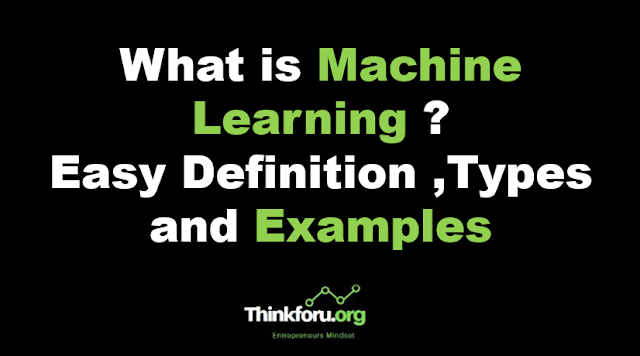What is Machine Learning ? Easy Definition ,Types and Examples
What is Machine Learning? Easy Definition, Types, and Examples
 |
| Cover Image of What is Machine Learning? Easy Definition,Types, and Examples |
Machine learning is a subset of artificial intelligence (AI) that enables computers to learn from data and improve their performance on a task without being explicitly programmed. It focuses on developing algorithms and models that can automatically learn and make decisions or predictions based on patterns and relationships within the data.
Machine Learning Easy Definition:
Machine learning involves teaching computers to learn from data and make decisions or predictions without explicit programming.
Types of Machine Learning:
1. Supervised Learning: The algorithm is trained on labeled data, meaning it learns from input-output pairs. It aims to learn a mapping function from input variables to output variables.
2. Unsupervised Learning: The algorithm is trained on unlabeled data, and it aims to find hidden patterns or structures within the data.
3. Semi-supervised Learning: A combination of supervised and unsupervised learning, where the algorithm is trained on a small amount of labeled data and a large amount of unlabeled data.
4. Reinforcement Learning: The algorithm learns to make decisions by interacting with an environment. It receives feedback in the form of rewards or penalties, which helps it learn the optimal strategy or policy.
Examples of Machine Learning Applications:
Image Recognition: Classifying images into different categories such as identifying objects in photographs.
Natural Language Processing (NLP): Analyzing and understanding human language, including tasks like sentiment analysis, language translation, and chatbots.
Recommendation Systems: Suggesting products, movies, or music based on past behavior and preferences.
Predictive Maintenance: Forecasting when equipment or machinery is likely to fail, allowing for preventive maintenance.
Fraud Detection: Identifying fraudulent transactions or activities by analyzing patterns and anomalies in data.
Autonomous Vehicles: Teaching vehicles to perceive their environment and make decisions based on sensor data.
Healthcare Diagnosis: Predicting diseases or medical conditions based on patient symptoms and medical history.
These examples illustrate how machine learning algorithms are used in various domains to automate tasks, gain insights from data, and make intelligent decisions.